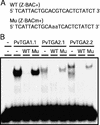Functional analysis of regulatory elements in the gene promoter for an abscission-specific cellulase from bean and isolation, expression, and binding affinity of three TGA-type basic leucine zipper transcription factors
- PMID: 12428013
- PMCID: PMC166667
- DOI: 10.1104/pp.007971
Functional analysis of regulatory elements in the gene promoter for an abscission-specific cellulase from bean and isolation, expression, and binding affinity of three TGA-type basic leucine zipper transcription factors
Abstract
Site-directed mutagenesis was used to identify cis-acting elements that control hormonal and abscission-specific expression of the bean (Phaseolus vulgaris) abscission cellulase (BAC) promoter. Auxin inhibition of BAC promoter expression is at least in part controlled by a negatively regulated element and ethylene induction by a positively regulated element. One of a series of 15 different 10-bp mutations created in a 2.9-kb BAC promoter reduced reporter gene expression by 60%. The native sequence for this 10-bp mutation includes a TGA-type basic leucine zipper (bZIP) motif. Tandem ligation of three 18-bp BAC elements (Z-BAC), which includes the bZIP motif to a minimal -50 35S cauliflower mosaic virus promoter, enhanced expression in abscission zones (AZs) 13-fold over that of the minimal promoter alone. The native forward orientation of the Z-BAC elements was essential for high expression levels. Expression of the Z-BAC minimal construct was 3-fold greater in AZ than stems when compared with the expression levels of an internal control with an enhanced 35S cauliflower mosaic virus promoter. Polymerase chain reaction was used to identify three TGA-type bZIP transcription factors in an AZ cDNA library. One of these factors was of the class I type and two of the class II type. RNA-blot analysis was completed for these genes and electrophoretic mobility shift assays used to confirm their binding to the Z-BAC element. Electrophoretic mobility shift assay-binding affinity was greatest for the class I TGA-type bZIP factor. The results indicate a complex interaction of negative and positive regulating transcription factors that control BAC gene expression.
Figures





Similar articles
-
The gene promoter for a bean abscission cellulase is ethylene-induced in transgenic tomato and shows high sequence conservation with a soybean abscission cellulase.Plant Mol Biol. 1996 Jun;31(3):595-606. doi: 10.1007/BF00042232. Plant Mol Biol. 1996. PMID: 8790292
-
In vitro binding of the tomato bZIP transcriptional activator VSF-1 to a regulatory element that controls xylem-specific gene expression.Plant J. 1996 Mar;9(3):283-96. doi: 10.1046/j.1365-313x.1996.09030283.x. Plant J. 1996. PMID: 8919907
-
Analysis of the spacing between the two palindromes of activation sequence-1 with respect to binding to different TGA factors and transcriptional activation potential.Nucleic Acids Res. 2002 Feb 1;30(3):775-81. doi: 10.1093/nar/30.3.775. Nucleic Acids Res. 2002. PMID: 11809891 Free PMC article.
-
Isolation of two soybean G-box binding factors which interact with a G-box sequence of an auxin-responsive gene.Plant J. 1995 Aug;8(2):199-211. doi: 10.1046/j.1365-313x.1995.08020199.x. Plant J. 1995. PMID: 7670504
-
TGA transcription factors-Structural characteristics as basis for functional variability.Front Plant Sci. 2022 Jul 26;13:935819. doi: 10.3389/fpls.2022.935819. eCollection 2022. Front Plant Sci. 2022. PMID: 35958211 Free PMC article. Review.
Cited by
-
Elymus nutans genes for seed shattering and candidate gene-derived EST-SSR markers for germplasm evaluation.BMC Plant Biol. 2019 Mar 13;19(1):102. doi: 10.1186/s12870-019-1691-4. BMC Plant Biol. 2019. PMID: 30866819 Free PMC article.
-
Reactive oxygen species in leaf abscission signaling.Plant Signal Behav. 2008 Nov;3(11):1014-5. doi: 10.4161/psb.6737. Plant Signal Behav. 2008. PMID: 19704438 Free PMC article.
-
Genome-wide identification and characterization of soybean GH9 endo-1,4-β-glucanases.Front Plant Sci. 2025 Jun 13;16:1597668. doi: 10.3389/fpls.2025.1597668. eCollection 2025. Front Plant Sci. 2025. PMID: 40584846 Free PMC article.
-
Citrus biotechnology: Achievements, limitations and future directions.Physiol Mol Biol Plants. 2009 Jan;15(1):3-22. doi: 10.1007/s12298-009-0001-2. Epub 2009 May 14. Physiol Mol Biol Plants. 2009. PMID: 23572908 Free PMC article.
-
Microarray analysis of the abscission-related transcriptome in the tomato flower abscission zone in response to auxin depletion.Plant Physiol. 2010 Dec;154(4):1929-56. doi: 10.1104/pp.110.160697. Epub 2010 Oct 14. Plant Physiol. 2010. PMID: 20947671 Free PMC article.
References
MeSH terms
Substances
Associated data
- Actions
- Actions
- Actions
LinkOut - more resources
Full Text Sources

